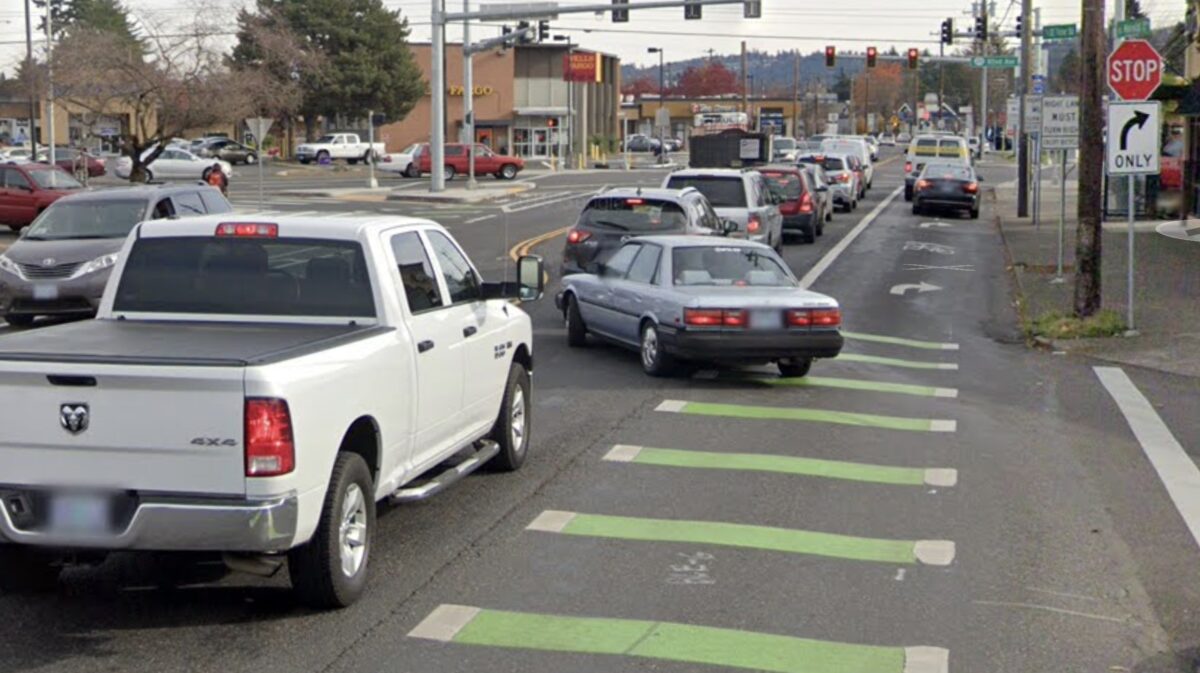
“I’ll admit if we could go back and do it over, I wish I’d included a middle option and evaluated it along with the others.”
— Zef Wagner, PBOT
When the Portland Bureau of Transportation came out with its evaluation of options for a redesign of Hawthorne Boulevard earlier this month, cycling advocates were crestfallen to say the least.
Bike lanes on this marquee commercial corridor have been a dream for years — not just to improve convenience for bicycle users, but to add some humanity to the beloved street and begin to create the conditions our climate and transportation plans envision.
Unfortunately, PBOT’s analysis (PDF) clearly favored an option without bike lanes. The way they presented the two options seemed to be, “intentionally stacking the deck in favor of a design that deprives Hawthorne of much-wanted, much-needed—and long-planned-for bike lanes,” is how one activist described it to me. Adding salt to the wound was the claim that the addition of bike lanes would be bad on climate change and racial equity grounds.
How? PBOT models showed that bike lanes on the street would lead to bus and auto user delays of 8 to 16 minutes. One PBOT project manager said the bike lanes would lead to a “pretty major traffic breakdown with queues stretching several blocks.” That added trip time wouldn’t be fair to transit users from east Portland (an equity focus area for PBOT) and it would cause some of them to drive instead.
Many people were concerned that PBOT’s framing was unfair and that it pitted bike lanes against climate change and racial equity.
Something didn’t add up.
In follow-up conversations with PBOT project staff at meetings of the city’s Bicycle Advisory Committee and Bike Loud PDX, we learned the source of this delay was a single intersection. Speaking at the Bike Loud meeting on September 16th, PBOT Project Manager Zef Wagner said, “The primary reason for the delay in the traffic analysis was the reduction of capacity at Cesar Chavez.”
In other words, a single intersection between SE 24th and 50th would cause the transit delays that made the bike lane option score so poorly in PBOT’s evaluation.
Advertisement

“If you present a new option that’s good for equity and climate with improved transit times, and the only compromise is a mixing zone where the conditions for crossing will be better than currently exists — I think that’s a really great compromise that a lot of people will be happy with.”
— Zach Katz, Healthier Hawthorne
Activists wondered why PBOT didn’t consider a mixing zone at that intersection which would likely eliminate the transit delay. A mixing zone is something PBOT does at busy intersections where the dedicated bike lane ends and bicycle users share the space with others (see lead image for example).
Turns out PBOT didn’t evaluate the mixing zone option because it’s considered a substandard cycling treatment. “We wanted to look at carrying a bike lane all the way through with no mixing zone or anything like that, because we thought it was important to evaluate sort of a pure option that actually meets our design guidelines. Mixing bikes and cars and buses is not a preferred option,” Wagner said.
After hearing feedback, PBOT now says they’re willing to consider a hybrid option that would include bike lanes on most of the street and a mixing zone at Cesar Chavez.
“Very often in a planning process, you present these sort of idealized alternatives, and then you see if there’s a way to kind of combine elements of them together. So there might be something in between,” Wagner shared. “I’ll admit if we could go back and do it over, I wish I’d included a middle option and evaluated it along with the others,” he continued. “At the time we it would seem like we were pre-compromising and the criticism would be, ‘Why are you doing that?’ But I can see the concern and frustration.”
Zach Katz with Healthier Hawthorne is among the local activists who pushed for this option and is happy that PBOT will be more flexible than their evaluation report suggests. “I think a lot of people were misled,” Katz said to Wagner at the Bike Loud meeting, “because they don’t want to rank something higher, that says that it’s gonna be bad for equity and climate. But if you present a new option that’s good for equity and climate with improved transit times, and the only compromise is a mixing zone where the conditions for crossing will be better than currently exists — I think that’s a really great compromise that a lot of people will be happy with.”
Keep in mind that even if this hybrid bike lane/mixing zone option alleviates transit delay concerns, tough conversations about tradeoffs likely remain. PBOT has made it clear that the myriad demands on Hawthorne — based on its classification in city plans as a Major Transit Priority Street, a Civic Collector, a Civic Main Street, and a City Bikeway — make compromises inevitable.
If you haven’t shared your feedback yet, please take the online survey which closes today (Wednesday 9/30). You can also email HawthorneRepave@portlandoregon.gov.
PBOT plans to come out with a recommendation in December.
To learn more, see the project website and check out this detailed Q & A on the project (PDF) between PBOT and the Bike Advisory Committee.
— Jonathan Maus: (503) 706-8804, @jonathan_maus on Twitter and jonathan@bikeportland.org
— Get our headlines delivered to your inbox.
— Support this independent community media outlet with a one-time contribution or monthly subscription.



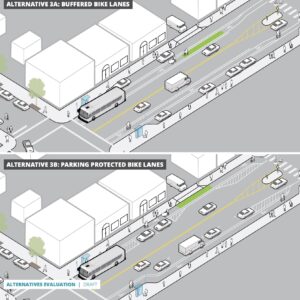
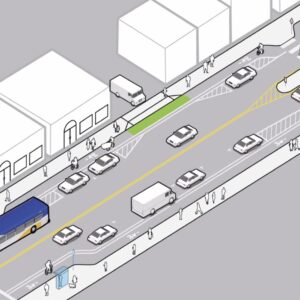
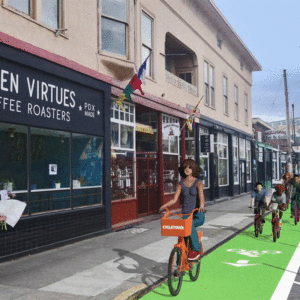
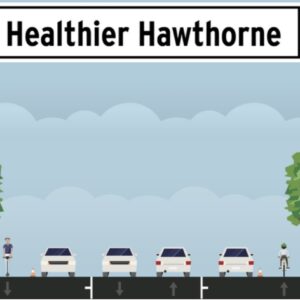
Thanks for reading.
BikePortland has served this community with independent community journalism since 2005. We rely on subscriptions from readers like you to survive. Your financial support is vital in keeping this valuable resource alive and well.
Please subscribe today to strengthen and expand our work.
Ah, yes, my favorite place to mix with traffic.
Not ideal.
But if it’s either a mixing zone or no bike lanes at all — wouldn’t you rather have the mixing zone?
No, it’s not ideal, but it is politically easier to upgrade an existing bike lane or mixed zone to something safer later on, than it is to get brand new infrastructure where there was none before.
You know, most of the travel time trade-offs disappear if we get rid of the assumption that we must save on-street parking and 24-hour delivery access.
That’s not true at all. Read the report and the FAQ, they explain why parking removal doesn’t really help.
This would be an absolutely stellar opportunity for you to quote the report, rather than just telling people to read it. For one reason, when you don’t direct the reader to a specific selection of words, they can cherry pick their own. You are abdicating your opportunity to influence the outcome of their experience.
Answer to the first question in the FAQ:
“Removing parking does not really have any effect on the level of traffic delay or traffic diversion. The parking is very often framed by curb extensions, and our pinch points are the roughly 40 feet available from one curb extension to the other. Furthermore, nearly all the traffic delay is due to the reduction in capacity at the Cesar Chavez intersection. That’s the critical point where modeling shows complete failure if we continue separated bike lanes through the intersection, causing cascading effects and extremely long queues resulting in the delay we talk about in the report. There is no parking already at Cesar Chavez approaches, so removing parking would not help or hurt the traffic or transit delay we talk about.”
The width on Hawthorne is set. Taking away parking does nothing because it necks down due to the sidewalk bulb-outs at most intersections. Removing bulb-outs would be too expensive and are thus out of scope for this repaving project.
An easier alternative would simply be limit cut through car commuter traffic by placing bus only signs at 12th, 20th, and 39th. This allows people to drive on Hawthorne locally. Use the bulb-outs to increase the width of the sidewalk. 6 lanes of cars turns into: 2 lanes of sidewalk, 2 lanes of protected bike lane, and 2 lanes of local traffic cars.
Isn’t that the bike advocate modus operandi? Consent to bad bike infrastructure that the marginal bike rider wont touch in a million years so we can have the Pyrrhic victory of “bike lanes”.
We have tons of useless “victories” all over the city.
You’d think with yet another report showing cycling dying in Portland, the BAC could grow some teeth and do what the Rose Quarter work group did. Apply pressure and quit if PBOT wont cave.
What they are doing now isn’t working.
Keep in mind that this is just one mixing zone that would “allow” them to build fully-protected bike lanes on the entire rest of the street. And that mixing zone could easily have real protection added later on. That’s a pretty solid compromise, IMO.
A bike lane is only as good as its weakest link.
And if I had a ten dolalrs for every spot in Portland that “could easily have real protection added later on”, I’d have enough to build real protection for cyclist on our streets.
Great point cmh89. Maybe we should back up and ask WHY we are forced to have this conversation continually. The answer IMO is clearly PBOT prioritizes car capacity and speed, making safe infrastructure a non-starter. I’d love to see that fancy pyramid again adopted by the city which has ped and cyclists at the top. Can someone re-edit that for PBOT?
I mean, I completely agree. But just to add some personal context, I spent hundreds of hours—and a lot of my own money—in March and April designing flyers, stapling hundreds of them around town, talking to 100+ business owners, making a website, attending neighborhood association meetings—a billion things—just to get PBOT to *consider* protected bike lanes as an option. I don’t mean to make this about me, though—all I’m saying is, given my relative “skin in the game,” and as someone who more than anything wants Portland to have a complete, all-ages protected bike network *with protected intersections* (I even worked with an urban planner to design what protected intersections on Hawthorne might look like—this is Hawthorne and 34th: https://ibb.co/XbBN1Sr), this mixing zone is a totally acceptable tradeoff for protected bike lanes on the rest of Hawthorne (well, from 24th to 50th).
Thanks for the work.
You bet. I appreciate you saying that.
Great work, Zach.
Awesome work indeed!
And I appreciate your work on this. It’s just not going to do anything to get people who don’t ride now out of their cars
Thanks. And sure, I mean, no one’s expecting one bike lane to turn Portland into Amsterdam overnight, but you’ve got to start somewhere. Every day, many people bike/scooter/skateboard on Hawthorne, and they either contend with dangerous traffic or ride on the sidewalk. Giving all of these people a safe place to ride will be huge enough in its own right. Even just tourists riding Lime scooters in the summer is a lot of people that will benefit from this.
But you’d be surprised. Many of my friends and neighbors drive from Belmont to Hawthorne (!) because they’re simply too scared to bike amongst cars—even on greenways! Truly separated, protected infrastructure is the only thing that will make everyone feel comfortable riding around their own neighborhood.
I get you Zach, and I think the current level of incivility in our society has amplified that. I know a number of people who have stopped biking completely since sometime this summer, retreating to their cars because it feels safer.
A couple months ago I would have put the word “safer” in quotes. Right now I can’t really blame anyone for feeling the need to be in a steel cage in which they can make a quick getaway from some asshole.
I appreciate it GlowBoy.
Agreed. I think there are also lots of people who felt uncomfortable biking amongst cars even before the pandemic. Even a friendly Volvo driver going 15mph and giving you plenty of space can be super intimidating and scary—enough to dissuade potential cyclists away completely.
“A bike lane is only as good as its weakest link.” I disagree. 25 blocks with one bad intersection is 25 good blocks minus one bad intersection. It’s not 25 bad blocks.
Plus, not all users will be using the entire route. They’ll benefit with no drawback at all, since they won’t be using the weak link.
That’s true. While it won’t be as much use as a through-route for bikes, at least you will be able to ride on it for a few blocks to access all of the shops and other destinations on the street itself. That’s the big thing that is missing right now.
Although I cannot quote specifics, I have read many times, that when citizens are asked why they don’t bike commute, they say it is too dangerous. When pressed, they point out one of two portions of their potential commute that are scary. It is also my personal experience. I do not commute in Bend, because there are no continuous east-west bike lanes. The best they have done is have those hybrid ‘car-bike share lanes’. Yeah sure, merge into 35 mph traffic for two blocks and then back onto my bike lane. Same thing with my recreational rides. There are several great loops that I don’t use because they have a mile or two of high-speed road with no shoulder to speak of.
Zach,
even if the mixing zone is included, PBOT is not proposing to build “fully-protected bike lanes on the entire rest of the street”. They are planning to build something between 50th and 24th. There would be a unaddressed gap between 50th where the new lane ends and 53rd, the nearest bike bike infrastructure as well as between 24th where the proposed bike lanes will end 12th where the existing lanes currently end. It seems so dumb and dangerous for PBOT to continue to build disconnected bike infrastructure.
Correct. I meant the rest of the project length, not the street. I agree they should go the entire length of the street.
Hawthorne east of 50th is a pretty quiet street and they can easily put down some sharrows to tie it into the 50s bikeway on 52nd. There isn’t such an easy answer at the west end of the project, but I don’t think a potential 12 block gap in the bike network should be the reason to do nothing.
How about a bus / bike lane instead? That would help even more with avoiding transit delays.
Yes, I’d rather see the mixing zone, and bike lanes the entire rest of the street. At least, I think so.
You know … I got honked at and yelled at last week while stopped for a red light in a mixing zone. The driver behind me wanted to turn right. I sure was glad the light turned a few seconds into his rant, before he got the chance to escalate things. The state of the streets right now is so sorry that, upon reflection, I was surprised it hadn’t happened to me at that location before.
Let’s hope the level of incivility right now is temporary and goes away in a year or two. Otherwise bike lanes on skinny Hawthorne are going to look pretty pathetic when everyone in Portland starts to realize they need nothing less than fully protected infrastructure EVERYWHERE, including at all intersections, to separate them from all the homicidal drivers currently feeling emboldened. Thank God I moved somewhere with a lot of protected bikeways. I am no longer using unprotected bike lanes at all, since last month.
Sounds nice, where did you move to?
Minneapolis. We have a couple hundred miles of protected bikeways within the city, and hundreds more in the metro area. Our on-street network of (unprotected) bike lanes is not as good as Portland’s, but that distinction is no longer relevant. As a mountain biker I also appreciate the 100 miles of single track we have within the metro area, also much of it accessible by protected paved bikeways.
How to manufacture consent to progressive Portlanders- tell them something is bad for equity and climate and hope they don’t interrogate those claims.
This entire conversation around whether or not we should even consider other modes (eg walking, biking) relies on a very big assumption: car capacity and speed are a given priority. What is an “appropriate” car capacity and speed? Why does that necessarily preclude other modes?
“The primary reason for the delay in the traffic analysis was the reduction of capacity at Cesar Chavez.”
Equity is now job #1 at PBOT, and for the purposes of this project, PBOT defined equity as motorized vehicle speed throughput in order to facilitate transit between Lents and downtown (which, for the purposes of this project was constrained to using Hawthorne, despite other, likely faster and “more equitable” routes being available).
By defining the problem the way they did, our newly “enlightened” PBOT prioritized capacity and speed, just like “dark ages” PDOT used to do.
Meet the new boss, same as the old boss.
Yes, indeed. Could not have said it better. Combination of pseudoscience, good intention and zero political will.
The solution set under consideration originally is also suspect. In addition to excluding this option, the solution set also didn’t include a bus lane in any of the options despite transit and equity purportedly being such high priorities.
“Mixing bikes and cars and buses is not a preferred option.”
So, instead of mixing traffic modes at one intersection… they would rather mix traffic modes for the ENTIRE length of Hawthorne? Because that’s what cyclists have to do if you don’t give us our own lane.
So PBOT built a street buffet on the Foster stroad yet refuses to take away car parking or car lanes on Hawthorne which has way more nearby bicycle greenways?
Greeenways, in the context that Hawthorne has more support for real bike lanes than the Foster project. One businesses went ape furious about the Foster road diet.
One thing they tend to not disclose in these plans are the crosswalk closures. Automobile right-of-way is never taken away without substantial chances for stakeholder input allowed, but 140 year old unmarked crosswalks are being removed overnight without input from the community, and without any prior notice. Closing intersections to peds is a technique used in car centric suburbs to discourage pedestrians as much as possible, and has no place in an urban environment. PBOT should not be in the business of closing 140 year old crosswalks. Its just embarrassing.
Which crosswalks are being closed?
They closed the 12th/Madison intersection a couple of years ago, right AFTER building an accessible ramp!
On previous projects PBOT closed unmarked crosswalks in the weeks after the ribbon cutting ceremony, and called it a “final touchup” or some such wording. The project discloser never included the closings. The automotive equivalent of this would be adding a few unannounced diverters to a new greenway in the weeks after the ribbon cutting, as a “final touchup”. Some people might like that technique, but it cheapens the process and creates mistrust.
How does PDOT define “capacity.” Any street can fit far more people on bikes than in cars. Is it human capacity, human transportation or just about moving smoking hunks of metal?
Pbot often uses the numbers from traffic counts at intersections to inform their decisions:
https://pdx.maps.arcgis.com/apps/webappviewer/index.html?id=7ce8d1f5053141f1bc0f5bd7905351e6
Pbot also counts bike trips on limited streets often via visual count (someone correct me if I’m wrong). It is perhaps a little too obvious to point out, but on stroads such as Hawthorne, pedestrian and bicycle trips are an afterthought at best. Count the number of people walking on I-5 or cars on a hiking path and you might get similar numbers.
Having taken some classes in transportation planning, I can tell you that traditionally “capacity” means moving car-sized chunks of metal, period.
“Turns out PBOT didn’t evaluate the mixing zone option because it’s considered a substandard cycling treatment.“
But isn’t this the job we pay PBOT to do? Iterate until they arrive at a solution that makes sense? Why why why couldn’t PBOT have arrived at this brilliant compromise/insight without external pressure?
no treatment, throwing up our hands, is surely even more substandard than this initially discarded compromise.
clowns.
I’ll go out on a limb and guess it’s because they’d get precisely the reaction you’re seeing here.
When the people providing the lion’s share of feedback are ideologues, anyone seeking sensible steps forward is guaranteed to be eviscerated — not much incentive to be practical.
Evaluating a street based on a single mode parking+capacity+speed does not strike me as sensible. Reactions to this are quite appropriate. If PBOT decided to design streets based on movement of people, not cars, the results and corresponding reactions would be different.
Just out of curiosity, how far do you actually need to travel and under what conditions?
My personal experience is that Portland is crazy easy. I know Hawthorne well. Certainly not optimal but not so bad.
Providing better lanes will noticeably increase the number of people willing to cycle that street. But if you think huge numbers of people will dump their vehicles to cycle distance in the dark and wet, you’re just kidding yourself.
If you really want to advance cycling in this town, you need to work with the drivers — many of whom are of limited means and who can’t afford to live close to where they work at low paying jobs.
There’s a reason why cycling infrastructure is associated with gentrification, and I’d go so far as to say that the vast majority that insist on it have no idea what cycling would mean for the vast majority of people.
Personally I prefer the older greenways adjacent to commercial streets. I still like Rodney better than vancouver/williams in most cases.
I wish Hawthorne bike lanes were more than just an excuse to make Hawthorne more pedestrian friendly. Cyclists take all the blame from drivers in that case, and we don’t even get very good cycling infrastructure.
Also, we can’t do it because of climate change and uh, oh yeah, equity! Hilarious. You just want a safe place to ride your bike? Do not oppose us or you will be cancelled! Racist.
Incredible. I hate mixing zones as much as anyone, not least because the bike-haters argue that bike lanes vastly reduce car capacity, when in fact these mixing zones pretty much minimize that. Meanwhile, while the congestion at these intersections is what makes these zones advantageous, it is also what makes them most dangerous to us. In other words, it is a blatant tradeoff of bike safety vs. car expediency.
Tell me: does that pedestrian-heavy intersections still have beg buttons that force pedestrians to wait an extra cycle to cross? Another sacrifice on the altar of car expediency.
All this said, I understand that sometimes it’s the tradeoff that has to be made. If mixing zones are what it takes to get bike lanes down Hawthorne, so be it. But still think about getting rid of the unconstitutional beg buttons.
I’m pretty sure that none of the signals on Hawthorne have “beg buttons.” They’re fixed-time just like downtown, where the pedestrian signal automatically comes up.
I specifically meant Chavez and Hawthorne. At least as of a year or two ago it still had beg buttons, and did not automatically give pedestrians a WALK.
I don’t know why Hawthorners have resisted this. It’s NOT a functional four lane street and hasn’t been for many years. Know how there’s places where you unconsciously pull your elbows in cycling, like riding in a pack or in the woods? Driving Hawthorne makes me do that in a car! The street should be one car lane each way, a left turn lane in the middle, and bike lanes.
Hawthorners did not resist this. It was the Hawthorne Blvd Business Association that engaged in a dirty and corrupt (back-room) fight to block safety improvements described in the 1997 Hawthorne Blvs Transportation Plan:
A copy of the plan (which can no longer be found on city sites):
https://core.ac.uk/download/pdf/36681262.pdf